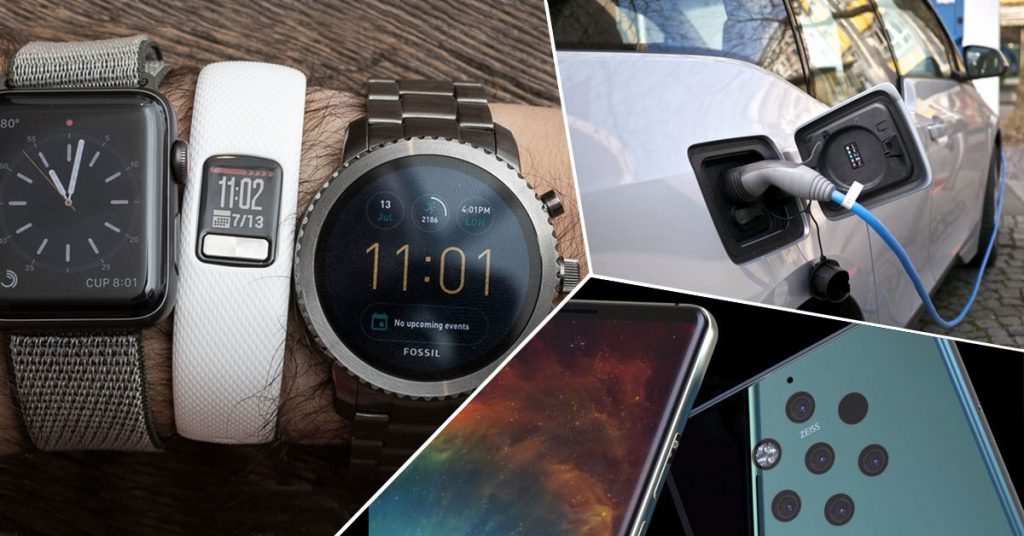The past year was an interesting one for fans of everyday tech and gadgets, with plenty of new developments and features appearing within the spaces of smartphones, computers, cars, and other everyday technology.
Some of these were completely new innovations (such as the under-display fingerprint scanner on the OnePlus 6T), others upgrades of things that already exist, but for certain most of these have changed how consumers look at and consume technology, and a good chunk have also set precedents for things to come in the future.
So looking ahead to 2019, we decided to take a stab the prediction game once more and place our bets for what’s to come in the next year.
1. Watch Out For The Smartwatch
This year saw some encouraging signs for the smartwatch segment, with sales figures encouraging in the second half of 2018 and manufacturers striving to innovate in what is still a relatively nascent market.

We saw options that catered to many niches, some purely for lifestyle, some for getting fit, and others even pandering to the extreme adrenaline junkie.
In 2019, we expect the smartwatch segment to see more in terms of sales and consumer options, with even more brands to enter the segment to see if they can steal a share of the Apple-dominated pie.
2. Goodbye, Notch
When Apple first introduced it with the iPhone X, it was the subject of derision, and then it become a smartphone mainstay accepted by consumers everywhere, albeit begrudgingly.
Left, right, and centre, the notch has been integrated into smartphones of all price points from all manufacturers save Samsung, who have refused to budge on their no-notch policy.
But those with an understanding of the smartphone industry will know that the end goal among manufacturers is a smartphone with an end-to-end display that is truly functional on a daily level.

True enough, we’ve already seen companies like Oppo, Vivo, and Honor all try their hand at crafting devices that allow for displays without bezels, and we’re hearing of tech that will eventually allow front cameras to sit underneath screens without sacrificing photo or display quality.
So in 2019, we fully expect these developments to spell the death knell for the notch, which will no doubt please more than a few.
3. More Triple Cameras For Everyone
The double camera lens setup has been a commonplace smartphone feature for a while now, with nearly every high-end flagship hopping on the bandwagon to stay relevant.
But as with most tech trends, performance and numbers are loathe to remain the same—processors will always demand more output despite having smaller footprints, screens will always get sharper resolutions, so on and so forth.

Case in point, this year saw the arrival of phones with more than two cameras. The Samsung Galaxy A7 and A9, and the Huawei P20 Pro and Mate 20 Pro all came with camera setups that promised the world in regards to camera capability, and the public ate them up gleefully.
Also, there were the leaked images of an upcoming Nokia device with five rear cameras and reports of LG’s new patent for a phone with 16 cameras. Make of them what you will.
So in 2019, we expect phones with triple cameras—or quadruple cameras even—to become something of a standard. Consumers are constantly demanding more from their devices, and manufacturers would be foolish to ignore them.
One maker has been consistently bucking that trend though: the Google Pixel 3 is still a single-lens camera for the back. They chose to put the dual camera on the front instead, to allow wide angle selfies. 2019 will tell us if they choose to add more to the back, but we predict that at most, it will be an additional single wide angle lens to match the one on the front.
4. Camera: Software Or Hardware?
This one comes as a bit of an antithesis to the previous point, but thanks to Google and the amazing Night Sight feature on their latest Pixel devices, there’s also a case to be made that camera quality is just as dependent on software as it is on hardware.
Stubbornly refusing to adapt to the multiple-lens trend as previously mentioned, Google has emphatically proven over and over that with an amazing software suite, one lens is as good (or even better than) a camera setup with multiple lenses.

While most manufacturers today are still focusing on camera hardware, expect more of them to follow Google’s lead in 2019 and begin chasing better camera software suites.
Want proof this will happen? OnePlus have also tried their hand at beefing up the software on their camera instead of purely touting hardware specs. While it’s not Google-levels of impressive, it’s a start.
5. Mid-Range Is The New Flagship
It’s hard to argue that 2018 was definitely the year of the mid-range smartphone. Sure, there were plenty of interesting entries in the flagship category, but you’d be crazy to dismiss just how strongly in demand the more affordable models were.
Thanks to devices like Xiaomi’s Poco F1, the OnePlus 6T, and the Honor Play, the mid-range category was completely turned on its head, proving to consumers that you don’t need to shell out a fortune in order to get class-topping performance.
In 2019, we expect more of the same or better, and we predict that phones providing more value for money will eventually begin to see the inclusion of features that you’d normally only see in devices with exorbitant prices. For proof, just look at the previously mentioned Samsung Galaxy A9, a mid-to-upper-range phone costing just under RM2,000 with four lenses in its rear camera setup—a first in any device.
As for flagship devices themselves, we feel they’ll do okay, but we also expect them to come with more cutting-edge features that fit particular niches, for example, the stylus on the Galaxy Note 9.
6. The Huawei-Samsung Grand Prix
If 2018 proved anything, it was the fact that Chinese smartphone manufacturers were out for blood. Once dubbed a region full of copycats and uninteresting cheap gizmos, Asia’s largest economic force has now drawn level with the best tech innovators in the world and have put out a serious number of inventive and class-leading devices in 2018 alone.
 Proving the point, Huawei in August leapfrogged Apple in global market shares and now sits second behind Samsung.
Proving the point, Huawei in August leapfrogged Apple in global market shares and now sits second behind Samsung.
But judging from the trajectory they’re on, we don’t expect them to stay there either. In 2019, we predict that Huawei will do just enough to edge out Samsung and end the year as the world’s leading smartphone manufacturer.
7. SEA Hello To Electric Vehicles
While the USA, China, and Europe have enjoyed the widespread availability of electric vehicles for approximately two years now, the rest of the world—including Southeast Asia—are still yet to see many of them on public roads, with petrol and diesel engines still the mot du jour.
In 2019, all that should change, with many SEA countries racing to make battery-only EVs more widespread in the coming year. This will no doubt be helped by manufacturers such as Nissan and even Dyson ramping up production within the region, and with administrations making an effort to transition the public to greener automotive options in the future.
The only stumbling block to this happening is the mentality of the market and whether or not administrations provide enough emphasis on creating enough charging stations in well-traveled locales.
-//-
Looking back at all we’ve witnessed in 2018 so far, it looks like an exciting year ahead for consumer technology. Whether or not our predictions come true, we’re eager with anticipation to see what else will happen in 2019 and how it’ll affect the way we work and live.
If you have any predictions of your own, feel free to leave them in the comments section below!
Feature Image Credit: MyMobilePhonePrice, Treehugger, Wirecutter














